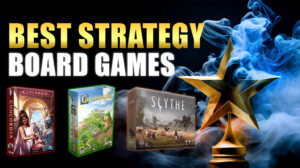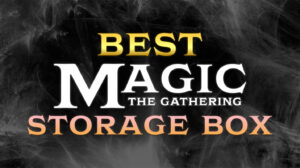20 Best Yu-Gi-Oh! Cards: Eternal Legends and Meta Picks
Eneba Hub contains affiliate links, which means we may earn a small commission if you make a purchase through them—at no extra cost to you. Learn more

There are a ton of Yu-Gi-Oh! cards in the world, but only a select few rightfully deserve the title of the best Yu-Gi-Oh! cards. And whether you’re a serious duelist, a returning player, or just like to collect cards, it’s important to know which ones are worth having.
That’s why I’m here. In this guide, I’ll run you through several of the best Yu-Gi-Oh! cards you can get, whether they’re for dueling, trading, or collecting just because they look neat.
Jump to:
Our Top Picks for Yu-Gi-Oh! Cards
We’ve got a lot of great cards on this list, but some of them are especially noteworthy:
- Ash Blossom & Joyous Spring – The best Yu-Gi-Oh! card that’s a core part of every modern deck.
- Exodia the Forbidden One – The sealed guardian is one of Yu-Gi-Oh!’s faces, and has new life as a rogue deck.
- Baronne de Fleur – A generic Synchro boss monster and one of the best Yu-Gi-Oh! cards that combine a big body with an omni-negate.
- Kashtira Fenrir – A dominant modern staple that pressures the field while disrupting your opponent’s plays.
- Blue-Eyes White Dragon – The iconic powerhouse monster that remains a symbol of Yu-Gi-Oh!’s legacy.
20 Best Yu-Gi-Oh! Cards Worth Collecting
Yu-Gi-Oh! has a gargantuan card library, and as such, picking out just a handful of cards for this list was no mean feat. After all, there are so many factors to account for, such as meta presence, splashability, history, card art, and collectibility.
Because of these, some cards had to fall by the wayside. While there’s a mix of timeless classics and heavy-hitting meta cards on this list, ultimately, there’s not enough space to accommodate them all (sorry, DAD).
With that out of the way, here are my picks for the best Yu-Gi-Oh! cards.
1. Ash Blossom & Joyous Spring [Best Must-Have Handtrap]

| Our Score | 10
☆
★
☆
★
☆
★
☆
★
☆
★
☆
★
☆
★
☆
★
☆
★
☆
★
|
| Card Type | Tuner Effect Monster |
| Monster Attribute | FIRE |
| Monster Type | Zombie |
| Level | 3 |
| ATK/DEF | 0/1800 |
| Rarity | Common to Quarter Century Secret Rare |
Ash Blossom & Joyous Spring is the best Yu-Gi-Oh! card that’s absolutely required in the best Yu-Gi-Oh! decks. And despite her cute appearance, Ash can be an instant game winner; I’ve personally won many duels with a well-timed Ash.
This power comes from her hand trap effect, where, if your opponent activates an effect with one of three conditions (add a card from Deck to hand, Special Summon from Deck, or send a card from Deck to graveyard – and no, I will not call it GY), you can counter with Ash, who negates that effect.
Ash is at her most powerful when you know exactly which parts of a combo you need to interrupt. A little studying goes a long way.
Modern Yu-Gi-Oh! lives and dies by its combo lines, and indeed, a deck’s resilience is often tested by its ability to play through multiple hand traps. If your deck dies to a single Ash, maybe it’s time to go back to the drawing board.
With all this power, you’d think that Ash would be difficult to purchase, but she surprisingly isn’t, as she’s received numerous releases and even a common release from a Structure Deck. However, she does have an alt art version, which is especially prized by collectors.
My Verdict: Ash Blossom & Joyous Spring is a must-have card for any modern Yu-Gi-Oh! Deck.
What do players say?
2. Exodia The Forbidden One [Iconic Anime Monster]
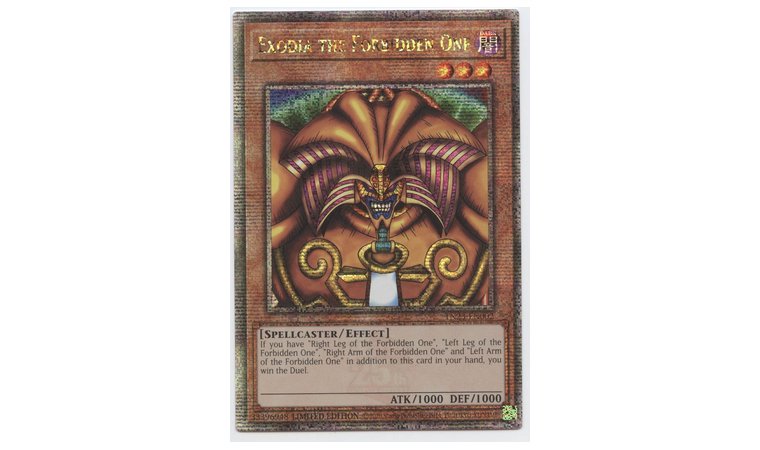
| Our Score | 9.5
☆
★
☆
★
☆
★
☆
★
☆
★
☆
★
☆
★
☆
★
☆
★
☆
★
|
| Card Type | Effect Monster |
| Monster Attribute | DARK |
| Monster Type | Spellcaster |
| Level | 3 |
| ATK/DEF | 1000/1000 |
| Rarity | Common to Quarter Century Secret Rare |
This iconic monster was Yugi’s most powerful card, featured in his first duel with Seto Kaiba. While Kaiba had the upper hand, Yugi was able to complete the pieces required to unleash Exodia the Forbidden One, allowing him to win the battle immediately.
This effect is replicated one-for-one in the trading card game. If you have Exodia the Forbidden One, along with his other parts (left/right arm, left/right leg), you reveal them immediately – even in the middle of a chain but not mid-effect resolution – and win the duel.
If you’re looking to use Exodia the Forbidden One in a modern deck, look to the Millennium archetype, specifically at The Unstoppable Exodia Incarnate.
Despite its apparent strength, this isn’t a solid win condition. Yes, defeating your opponents without touching their life points at all is fun, but if a single Ash or Droll & Lock Bird can stop your combo, then maybe it’s not a very good combo to begin with.
But regardless of its playability, none can debate just how iconic Exodia is, so much so that I’d argue that it’s an iconic, perhaps the most iconic monster in the franchise.
My Verdict: Exodia the Forbidden One isn’t a particularly strong card, but its iconic status and history make it impossible to ignore for any collector.
What do players say?
3. Baronne de Fleur [Powerful Generic Synchro Boss]

| Our Score | 9.5
☆
★
☆
★
☆
★
☆
★
☆
★
☆
★
☆
★
☆
★
☆
★
☆
★
|
| Card Type | Synchro Effect Monster |
| Monster Attribute | WIND |
| Monster Type | Warrior |
| Rank | 10 |
| ATK/DEF | 3000/2400 |
| Rarity | Ultra Rare (Legendary Duelists: Synchro Storm, Maze of Memories), Collector’s Rare (Maze of Memories) |
Just like the best Magic the Gathering cards, if you can run Baronne, there’s no reason not to include her in your deck.
For those unfamiliar with her, Baronne de Fleur is a 3000 ATK, Level 10 Synchro monster that uses the standard 1 Tuner + 1+ Non-Tuner materials. Once she hits the field, Baronne leads the charge with her once-per-turn target destruction effect, as well as a one-time omni-negate.
Since Baronne’s omni-negate is “once while face-up”, you can either flip her face-down or temporarily banish her with S:P Little Knight to make her “forget” she used that effect.
While 3000 ATK and an omni-negate are the standard for deck bosses, what makes Baronne de Fleur especially egregious is her completely generic summoning materials. This means that any deck capable of making Baronne will very likely include her. And even if a deck isn’t Synchro-focused, many of them can get access to Baronne with a single Tuner, like Ash.
All these factors come together to make Baronne a simple but excellent card that’ll go on to win many duels. So many, in fact, that people complained, and Konami banned Baronne de Fleur in the TCG format.
My Verdict: Baronne de Fleur offers a combination of power and utility that’s incredibly difficult to beat.
What do players say?
4. Kashtira Fenrir [Great Splashable Generic Removal]

| Our Score | 9.5
☆
★
☆
★
☆
★
☆
★
☆
★
☆
★
☆
★
☆
★
☆
★
☆
★
|
| Card Type | Effect Monster |
| Monster Attribute | EARTH |
| Monster Type | Psychic |
| Level | 7 |
| ATK/DEF | 2400/2000 |
| Rarity | Ultra Rare (Darkwing Blast, 25th Anniversary Tin: Dueling Heroes Mega Pack), Ultimate Rare (OTS Tournament Pack 21) |
If the Kashtira archetype had to be boiled down to one card, there’s no question that that card would be Kashtira Fenrir. This guy is so strong that it’s currently banned in the OCG format.
Fenrir is a Level 7 EARTH Psychic monster that shares the common Kashtira summoning condition, where you can Special Summon it from your hand if you control no monsters. This is trivial to fulfill: just plop down Fenrir on your first turn.
Fenrir has two abilities. The first is a neat ability for its home archetype: once per turn, you can add another Kashtira monster from your deck to your hand. A good effect, but it’s the second one that really makes Fenrir a beast to be reckoned with.
You may also be interested in Kashtira Unicorn – Fenrir can search it out, and instead of removing a card on the field, it snipes the opponent’s Extra Deck.
The second effect goes as follows: when Fenrir attacks or when your opponent activates any monster card effect, you can target one of your opponent’s face-up cards and banish it face-down. For reference, face-down banished cards are the closest you’ll get to removing an opponent’s card from the duel permanently.
The real prize, however, is in how easy it is to summon Fenrir – it can be added into virtually every deck and offers consistent, deadly interruption.
My Verdict: Kashtira Fenrir is a supremely splashable card that offers powerful and virtually permanent removal.
What do players say?
5. Blue-Eyes White Dragon [One of Yu-Gi-Oh!’s Faces]

| Our Score | |
| Card Type | Normal Monster |
| Monster Attribute | LIGHT |
| Monster Type | Dragon |
| Level | 8 |
| ATK/DEF | 3000/2500 |
| Rarity | Common to Quarter Century Secret Rare |
In the early days of Yu-Gi-Oh!, Blue-Eyes White Dragon was the undisputed king of the playground, thanks to its almost insurmountable base ATK. Back then, nothing could beat this living legend without support, and let’s face it – back then, duels were about who could field the biggest ace monster.
Even today, Blue-Eyes White Dragon remains a prized collector’s item. Despite this card not being as tooth-pullingly rare as it is in the anime – it’s pretty common, in fact – it has a lot of rare reprints in both modern and retro packs, as well as a ton of alt art that makes it a prized card for serious collectors.
Blue-Eyes White Dragon remains relevant today thanks to support from the Primite archetype, which incentivizes the use of powerful Normal Monsters.
Blue-Eyes White Dragon lives on in the Blue-Eyes archetype, which features retrains of the original dragon as well as alternative forms and powerful support. These decks aren’t meta contenders, but they’re solid rogue picks and great for beginners – as well as a reminder of the glory and lineage that Blue-Eyes White Dragon represents.
My Verdict: Blue-Eyes White Dragon’s glory days are behind it, but none can deny that it’s one of the faces of Yu-Gi-Oh!.
What do players say?
6. Called by the Grave [Anti-Hand Trap Tech Option]
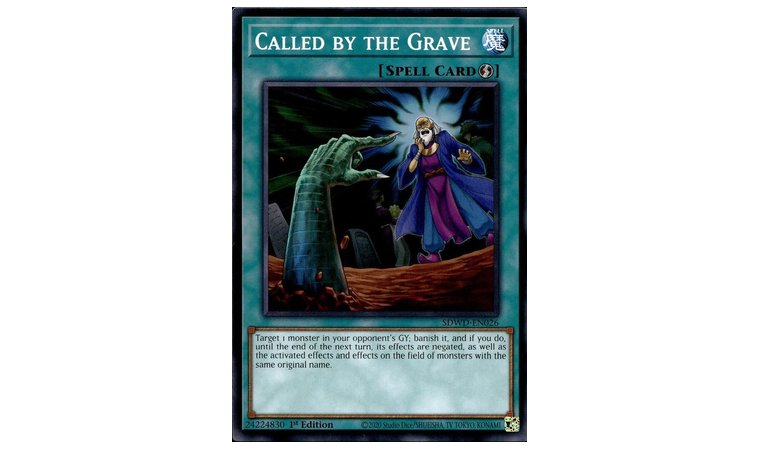
| Our Score | 9
☆
★
☆
★
☆
★
☆
★
☆
★
☆
★
☆
★
☆
★
☆
★
☆
★
|
| Card Type | Quick-Play Spell |
| Rarity | Common to Quarter Century Secret Rare |
Like Ash, Called by the Grave is a powerful card that’s omnipresent in the modern era of Yu-Gi-Oh!. And as with Ash, it has a deceptively simple effect.
What Called by does is banish a monster in your opponent’s graveyard, and until the end of the next turn, negate both that monster’s effect as well as all activated and on-field effects of monsters with the same name. This means that it shuts down all manner of graveyard-triggered effects – and can win you the duel on its own if you negate a vital play.
If you use Called by on a card, don’t forget to account for the negation on your turn.
Unlike most hand traps, Called by is a Quick Play spell. Notably, this means that Called by can only be played from the hand on your turn and must be set to play on your opponent’s turn. This makes it a little less flexible than other hand traps, though its ability to shut out a potentially game-ending trap from your opponent’s hand is very, very important.
My Verdict: Called by the Grave is a must-have staple card that helps protect your combo lines and stops other hand traps.
What do players say?
7. Infinite Impermanence [Fast Negate for Field Monsters]

| Our Score | |
| Card Type | Normal Trap |
| Rarity | Common to Quarter Century Secret Rare |
Like fellow hand traps Ash and Called by, Infinite Impermanence (abbreviated to Imperm) is a simple yet immensely powerful effect that can single-handedly win the game.
All Imperm does is simple: target 1 monster your opponent controls and negate its effects until the End Phase. However, Imperm also has the advantage of being activatable from your hand if you control no cards. A set of 3 Effect Veilers and 3 Imperms means that you’ll have a decent chance of stopping at least some of your opponent’s plays on the first turn.
It gets better though. Since Imperm is a trap, it can be set on your field to be triggered on your opponent’s turn. When flipped face-up, it gains an additional effect where it negates the effects of spells and traps activated in its column.
Be mindful of Imperm’s column negation effect – it’ll negate your own spells and traps too.
Once again, a well-timed Imperm stops combos dead in their tracks. Just make sure you Imperm the right step in your opponent’s plays, and you’re good to go.
My Verdict: Infinite Impermanence’s fantastic effect and double utility means that no serious competitive player should go without it.
What do players say?
8. Divine Arsenal AA-ZEUS – Sky Thunder [Excellent Board Wipe Boss]
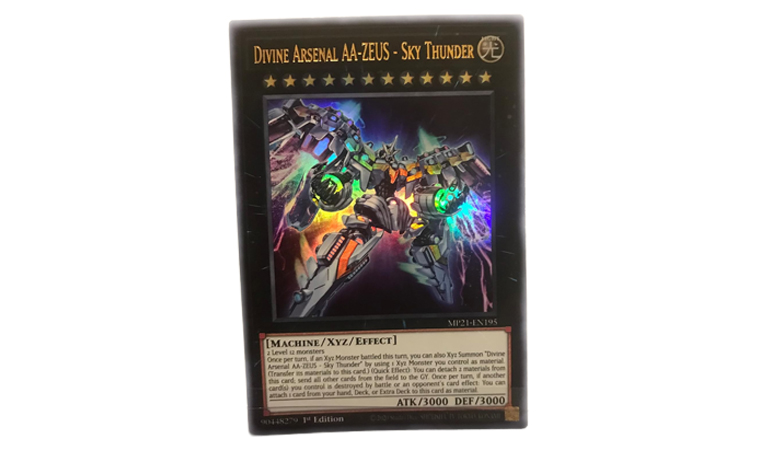
| Our Score | 8.5
☆
★
☆
★
☆
★
☆
★
☆
★
☆
★
☆
★
☆
★
☆
★
☆
★
|
| Card Type | Xyz Effect Monster |
| Monster Attribute | LIGHT |
| Monster Type | Machine |
| Rank | 12 |
| ATK/DEF | 3000/3000 |
| Rarity | Ultra Rare to Quarter Century Secret Rare |
When Zeus is loose, your opponent can kiss their field goodbye. This mighty machine monster is a worthy addition to any deck that runs at least some Xyz monsters.
A Rank of 12 may seem intimidating, but luckily, Zeus has an alternative summoning condition: if an Xyz monster battles, you can Overlay into Zeus using any Xyz monster you control. Because of this, bringing out Zeus is trivially easy, especially if you’ve got Xyz monsters that can safely attack, like Lyrilusc – Assembled Nightingale.
If you have 2 Xyz monsters and are in a bad spot, you can crash with one and turn the other into Zeus in the next phase.
Not only does Zeus have a mighty 3000 ATK/DEF score, but it also has an incredible removal effect. As a quick effect, you can detach 2 materials from Zeus to send all other cards on the field to the graveyard. And as if that wasn’t enough, this isn’t a once-per-turn effect.
Lastly, Zeus has an effect where it can attach extra materials to itself when another of your cards is destroyed, but let’s face it – if the thunder bringer sublimes an overcommitted field, you’ve pretty much won the duel.
My Verdict: Great stats, a quick-play board wipe, and an easy summoning condition all mean that Zeus is an easy auto-include in decks that run Xyz monsters.
What do players say?
9. Effect Veiler [Effect Negation Hand Trap]
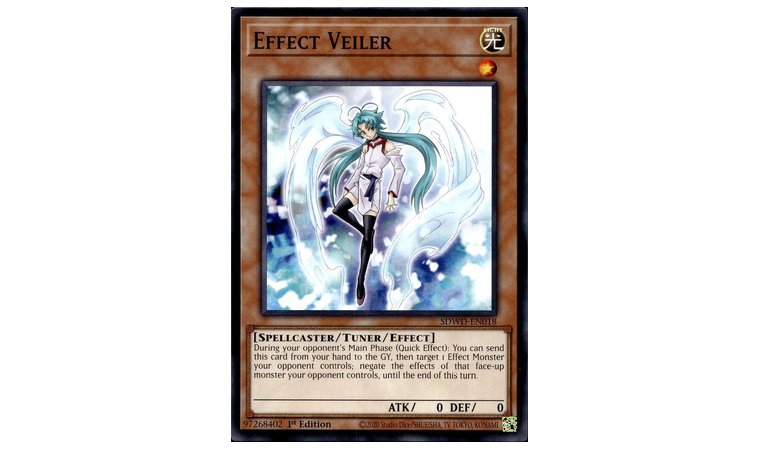
| Our Score | 8.5
☆
★
☆
★
☆
★
☆
★
☆
★
☆
★
☆
★
☆
★
☆
★
☆
★
|
| Card Type | Tuner Effect Monster |
| Monster Attribute | LIGHT |
| Monster Type | Spellcaster |
| Level | 1 |
| ATK/DEF | 0/0 |
| Rarity | Common to Quarter Century Secret Rare |
Effect Veiler is one of the first hand traps (apart from Honest) to see widespread use, and while it’s overshadowed by modern takes on hand traps, it’s still a card worth considering.
As with the other hand traps and staples on this list, Effect Veiler has a simple effect. During your opponent’s Main Phase, you can send Effect Veiler to the graveyard to target an effect monster your opponent controls, then negate its effects until the end of the turn.
Effect Veiler is strong, but keep in mind that it can only activate during your opponent’s Main Phase. This limits its use against decks that play on your turn.
I said it earlier, and I’ll say it again – the modern game is incredibly reliant on combos, so any card that can stop your opponent from reaching their ideal end board is powerful. And as with Ash, it’s especially satisfying to use Effect Veiler to shut down that one card that will kick off a combo domino.
My Verdict: While Effect Veiler is a bit more restrictive than other hand traps, it’s still a strong card that can help you secure the advantage in a duel.
What do players say?
10. Lightning Storm [Flexible Going Second Board Wipe]

| Our Score | 8.5
☆
★
☆
★
☆
★
☆
★
☆
★
☆
★
☆
★
☆
★
☆
★
☆
★
|
| Card Type | Normal Spell |
| Rarity | Ultra Rare to Collector’s Rare, also has Pharoah’s Rare edition (Magnificent Mavens) |
As with many powerful cards on this list, Lightning Storm shines in just how simple yet effective it is. All that Lightning Storm does is either destroy all attack position monsters on your opponent’s field or all their spells and traps.
It’s often a good idea to bait negates with cards like Effect Veiler or Infinite Impermanence. That way, your Lightning Storm is sure to resolve.
While you’d normally have to bring either Raigeki/Dark Hole and Harpie’s Feather Duster, Lightning Storm combines all that utility in just one card, making Lightning Storm a beloved staple, especially in going second decks.
One last thing you should remember: Lightning Storm requires you to have no face-up cards to activate.
My Verdict: Lightning Storm offers a brutally simple solution to clearing your opponent’s board. You’ll definitely want a few copies, especially if your deck likes going second.
11. Harpie’s Feather Duster [Ultimate Backrow Clearing]

| Our Score | 8.5
☆
★
☆
★
☆
★
☆
★
☆
★
☆
★
☆
★
☆
★
☆
★
☆
★
|
| Card Type | Normal Spell |
| Rarity | Common to Quarter Century Secret Rare |
No matter how old Yu-Gi-Oh! gets, backrow support will always be important. And when it comes to breaking said support, nothing does it better than Harpie’s Feather Duster.
Once again, we have a card with a simple yet devastatingly powerful effect. When played, Harpie’s Feather Duster destroys all of your opponent’s spells and traps, no questions asked.
Not every deck runs a heavy backrow, so you might want to keep this card in your side deck.
While Harpie’s Feather Duster is a one-line card, don’t underestimate its impact. From dealing with annoying floodgates to key support, to nuking Crystal Beasts if your opponent is a crazy person trying to play Rainbow Dragon, Harpie’s Feather Duster is a one-card solution.
My Verdict: The original Harpie’s Feather Duster still does backrow hate the best, despite the many tools offered in modern Yu-Gi-Oh!.
What do players say?
12. Accesscode Talker [Powerful Generic Link Boss]

| Our Score | 8.5
☆
★
☆
★
☆
★
☆
★
☆
★
☆
★
☆
★
☆
★
☆
★
☆
★
|
| Card Type | Link Effect Monster |
| Monster Attribute | DARK |
| Monster Type | Cyberse |
| Link Rating | 4 |
| ATK | 2300 |
| Rarity | Secret Rare to Quarter Century Secret Rare |
Just like Baronne de Fleur, Accesscode Talker is a generic yet extremely powerful Extra Deck boss, but this time, it’s for Link decks.
Stats-wise, Accesscode Talker may look rather measly at just 2300 ATK, but when summoned, you can target a Link monster that was used as material, and Accesscode gains ATK equal to 1000 x the target’s Link rating. This means that using a Link-3 as material gives Accesscode 5300 ATK – sure to leave a dent in your opponent’s life points
For clearing the field, Accesscode can banish a Link monster from your field or graveyard to non-target destroy 1 of your opponent’s cards, with the caveat that it can only pop once per Attribute of Link monster banished, and you can’t banish the same Attribute in one turn. However, this isn’t a once-per-turn effect.
As if the destruction effect wasn’t enough, Accesscode is utterly brutal in Maliss decks, due to their Link monsters returning when banished.
Just those two effects together would already make for a fantastic end piece, but that’s not all. The best part of Accesscode Talker is that your opponent cannot respond to any of its effects. This means that outside of built-in protection, nothing can stand in the way of this mean machine.
My Verdict: Accesscode Talker is an amazing boss for Link decks due to its generic materials and duel-ending effects.
What do players say?
13. Lovely Labrynth of the Silver Castle [Trap Archetype Centerpiece]
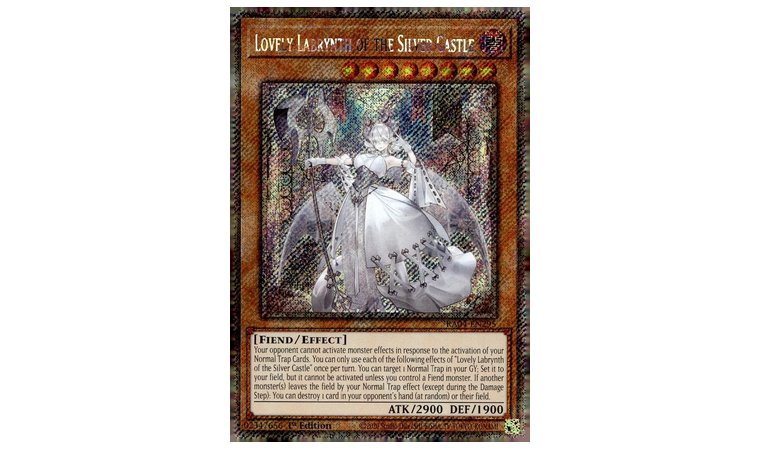
| Our Score | 8
☆
★
☆
★
☆
★
☆
★
☆
★
☆
★
☆
★
☆
★
☆
★
☆
★
|
| Card Type | Effect Monster |
| Monster Attribute | DARK |
| Monster Type | Fiend |
| Level | 8 |
| ATK/DEF | 2900/1900 |
| Rarity | Ultra Rare to Quarter Century Secret Rare |
Trap cards are held to be pretty bad by the community. The fact that they needed two turns to set up made traps easy to avoid or counter. So a lot of people were pleasantly surprised when Lovely Labrynth of the Silver Castle (and her archetype) was released.
As a trap-centric deck boss, you want to turbo out Lovely every chance you can get. This is due to her three powerful effects.
First, your opponent cannot chain monster effects to your Normal Trap activations. Second, you can set a Normal Trap from your graveyard, with the condition that you can’t activate that unless you control a Fiend monster (which Lovely and the rest of her archetype are).
Lastly, if another monster(s) leaves the field via your Normal Trap effect, you can destroy a card at random in your opponent’s hand or one on their field.
Lovely Labrynth’s 3rd effect doesn’t target, so keep that in mind when selecting what traps go into your deck.
All these come together for a deck boss that not only has a respectable stat line, but enables a powerful control playstyle designed to thwart your foe at every turn.
My Verdict: Duelists looking to play a slower control game and outgrind their foe with raw card advantage should consider Lovely Labrynth of the Silver Castle as their centerpiece.
What do players say?
14. Eldlich The Golden Lord [Control Archetype Boss]

| Our Score | 8
☆
★
☆
★
☆
★
☆
★
☆
★
☆
★
☆
★
☆
★
☆
★
☆
★
|
| Card Type | Effect Monster |
| Monster Attribute | LIGHT |
| Monster Type | Zombie |
| Level | 10 |
| ATK/DEF | 2500/2800 |
| Rarity | Common to Quarter Century Secret Rare |
This fashionable zombie reigns king supreme of his archetype, and not unlike Labrynth, utilizes control cards to direct the flow of the duel and deliver you victory.
Stats-wise, Eldlich is quite decent, but it’s his effects you really want. Eldlich’s first effect is a removal effect while in your hand, and due to how it’s worded, this effect gets around destruction protection.
But what’s even better is that when he’s in the graveyard, Eldlich can bounce back to your hand, then Special Summon a zombie (including himself) and give it 1000 extra ATK and destruction immunity until the end of the next turn. A 3500 ATK, destruction-immune Eldlich usually isn’t enough to win the game on his own, but he will pave the way for the rest of your deck.
None of Eldlich’s effects activate on the field, so you can easily run Skill Drain alongside him.
Lastly, while Eldlich shines in a control deck setup, he’s also very versatile. Not only does his presence and his bag of Eldlixirs grant him a good home in any zombie deck, but he’s also found his way into decks that want to send their spells and traps to the graveyard, like White Forest.
My Verdict: Eldlich the Golden Lord shines as the centerpiece of his own archetype, but his ease of use makes him a good candidate for other decks as well.
What do players say?
15. Nibiru, the Primal Being [Great Combo Punisher]
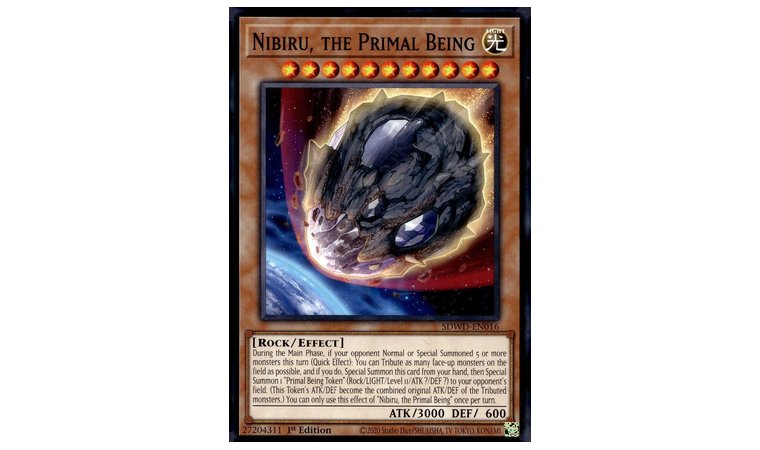
| Our Score | 8
☆
★
☆
★
☆
★
☆
★
☆
★
☆
★
☆
★
☆
★
☆
★
☆
★
|
| Card Type | Effect Monster |
| Monster Attribute | LIGHT |
| Monster Type | Rock |
| Level | 11 |
| ATK/DEF | 3000/600 |
| Rarity | Common to Quarter Century Secret Rare |
Modern Yu-Gi-Oh! decks often have elaborate combo lines, where one normal summon ends up searching half the deck and ending on an unbreakable board. But sometimes, all you need to break said board is to throw a really big rock at it.
Nibiru, the Primal Being is, coincidentally, a very big rock at 3000 ATK. However, the reason people use this card is because of its effect. During the Main Phase, if your opponent has summoned at least 5 monsters on this turn, you can activate Nibiru’s effect.
Once that happens, Nibiru will tribute as many face-up monsters on the field as possible to Special Summon itself to your field. Your opponent, on the other hand, will get a token whose ATK/DEF are equal to the sum of all tributed monsters. A big body, to be sure, but one easily popped with a removal effect.
Make sure you have a backup plan for getting rid of Nibiru’s token, and keep in mind that tokens cannot be banished face-down.
This means that Nibiru is excellent at punishing combos, and, most importantly, doesn’t outright destroy monsters, thus negating their protection and preventing a lot of floating effects from triggering.
Lastly, because Nibiru is such a persistent threat, most decks will attempt to set up an omni-negate on or before their 5th summon. You won’t be immune to this, so I strongly suggest that you practice building fast, powerful boards.
My Verdict: Nibiru, the Primal Being is a perfect counter to the modern Yu-Gi-Oh! metagame of long combos.
What do players say?
16. Dark Magician [Renowned Anime Monster]
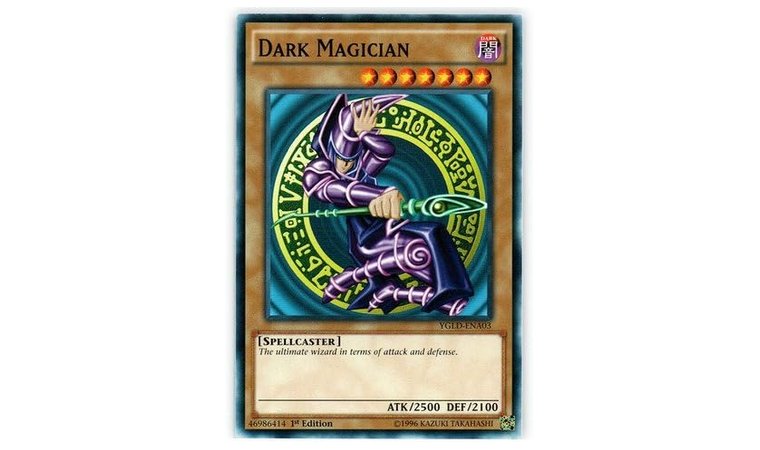
| Our Score | 7.5
☆
★
☆
★
☆
★
☆
★
☆
★
☆
★
☆
★
☆
★
☆
★
☆
★
|
| Card Type | Normal Monster |
| Monster Attribute | DARK |
| Monster Type | Spellcaster |
| Level | 7 |
| ATK/DEF | 2500/2000 |
| Rarity | Common to Quarter Century Secret Rare |
As with Blue-Eyes White Dragon, no list of the best Yu-Gi-Oh! cards can be complete without Yami Yugi’s iconic boss monster. While it’s never been one of the best Yu-Gi-Oh! cards, Dark Magician’s status within the community and anime fandom are what give it its place in this list.
Even in the early days, this card wasn’t even the best high-level monster you could field. Blue-Eyes White Dragon was a clear upgrade for the same cost, and Summoned Skull cost 1 less tribute for the same punching power.
Konami realized this, so they gave this wizard a personal suite of spell and trap support to distinguish him. This collection of personal cards started with Thousand Knives way back in a retro back from 2008, and continues until today – though debate rages on if they’re enough to keep this card afloat.
As with Blue-Eyes White Dragon, the Primite archetype breathed new life into Dark Magician – especially because using him to “properly” summon Red Eyes Dark Dragoon is a handy tech option.
But while the card is hardly meta viable, it can still be a strong rogue contender and remains a fun deck for those who play casually.
My Verdict: Dark Magician remains a solid card for collectors and casual players while still playable as a rogue deck.
What do players say?
17. Springans Merrymaker [Simple Combo Starter for New Players]
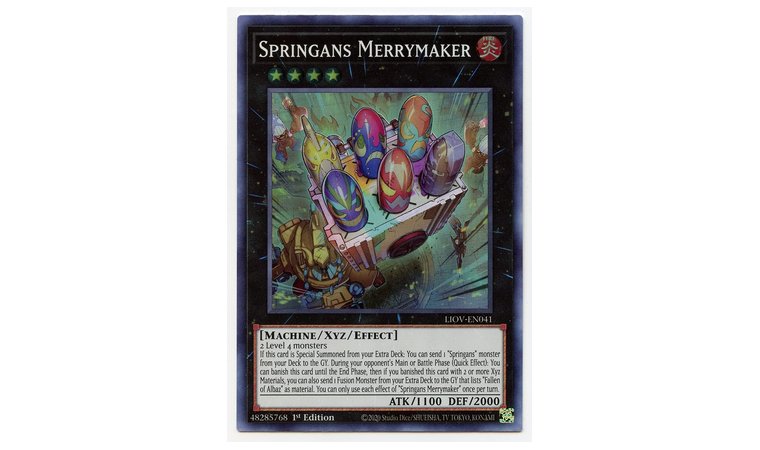
| Our Score | 7.5
☆
★
☆
★
☆
★
☆
★
☆
★
☆
★
☆
★
☆
★
☆
★
☆
★
|
| Card Type | Xyz Effect Monster |
| Monster Attribute | FIRE |
| Monster Type | Machine |
| Rank | 4 |
| ATK/DEF | 1100/2000 |
| Rarity | Super Rare (Tactical Masters) |
If you’re a returning player, Springans Merrymaker is a good card to start learning combos with, as it’s got a simple yet effective combo line that can branch out to a lot of different Extra Deck plays.
On its own, Merrymaker isn’t much. It’s a simple 1100 ATK/2000 DEF Xyz Monster that searches and dumps a Springans monster. Typically, you’ll dump a monster that can reattach itself as Xyz material to Merrymaker.
Once that’s accomplished, you’ll Xyz Summon Gigantic “Champion” Sargas using its alternate summoning condition. Sargas then searches out a Springans or Therion card, but your ideal target will always be Tally-Ho! Springans, which, coincidentally, features Merrymaker on its art.
If you want a simple omni-negate, you can also do Merrymaker -> Gigantic “Champion” Sargas -> Therion “King” Regulus.
Tally-Ho! then detaches 2 materials from Sargas to both search for a Springan in your deck and swarm the field. Once you reach that point, anything goes!
While Merrymaker’s combo is simple, it’s very effective, especially if you use cards like Great Sand Sea – Gold Golgonda to preserve your Normal Summon.
My Verdict: The simplicity and effectiveness of Springans Merrymaker’s combo is a good starting point for both returning players and duelists looking for new swarm lines.
What do players say?
18. Red-Eyes Black Dragon [Versatile Anime Monster]
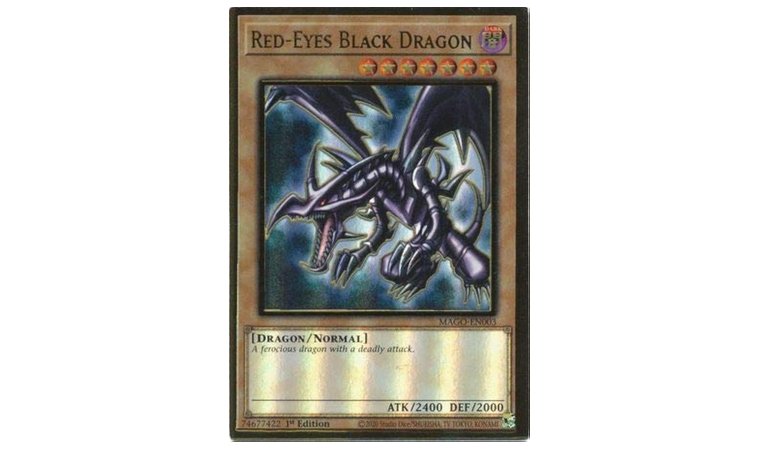
| Our Score | 7
☆
★
☆
★
☆
★
☆
★
☆
★
☆
★
☆
★
☆
★
☆
★
☆
★
|
| Card Type | Normal Monster |
| Monster Attribute | DARK |
| Monster Type | Dragon |
| Level | 7 |
| ATK/DEF | 2400/2000 |
| Rarity | Common to Quarter Century Secret Rare |
I’ll be frank: Red-Eyes Black Dragon is terrible. A 2 tribute monster for just 2400 ATK is an awful deal – even as a retro back boss monster. Little wonder this card barely saw any play. However, it did see a lot of prominence due to both being Joey Wheeler’s ace as well as being the subject of many, many retrains and fusions.
Let’s name some of them: zombie support, fusions with Summoned Skull and Meteor Dragon, the early 2010’s meta-defining Red-Eyes Darkness Metal Dragon, XYZ retrains (some of which can cause funny infinite combos), and more. Gotta give this dragon credit – it’s far from the best, but it’s determined to put up a good fight no matter where it goes.
Modern Yu-Gi-Oh! decks use the classic Red Eyes Black Dragon to fusion summon Red Eyes Dark Dragoon – made easier with Primite support and Red Eyes Fusion.
And while the results of Konami’s experimentation is debatable, few will debate that due to how much support the Red-Eyes archetype has, it boasts a supremely versatile playstyle.
My Verdict: Red-Eyes won’t win any points for raw strength, but its tenacity, multiple archetypes, and awesome design make it a worthy addition to any collection.
What do players say?
19. Slifer the Sky Dragon [Must-Have Collection Card]
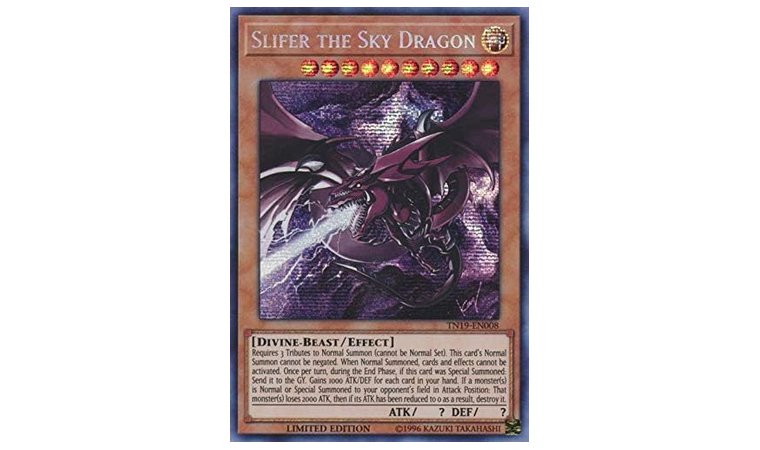
| Our Score | 7
☆
★
☆
★
☆
★
☆
★
☆
★
☆
★
☆
★
☆
★
☆
★
☆
★
|
| Card Type | Effect Monster |
| Monster Attribute | DIVINE |
| Monster Type | Divine-Beast |
| Level | 10 |
| ATK/DEF | ?/? |
| Rarity | Common to Quarter Century Secret Rare. |
Many kids probably went “Slifer is one of the best Yugioh cards ever!!!” after that particular anime episode. So they were also probably baffled by just how bad the playable version of Slifer the Sky Dragon is.
Despite being touted as one of the world’s most powerful cards, the playable Slifer is…awful. It can be Normal Summoned by tributing a whopping 3 monsters (a massive card advantage loss in itself), but at the very least, its summon can’t be negated. It can also be Special Summoned, but it sends itself to the graveyard at the end of the turn.
For combat, Slifer gains 1000 ATK/DEF for each card in your hand. Finally, if your opponent summons a monster in Attack Position while Slifer is on the field, it loses 2000 ATK, and if it hits 0 via this effect, it’s destroyed.
If you really like the ATK reduction + destruction effect of Slifer the Sky Dragon, King Tiger Wanghu gives you virtually the same effect, and is easier to set up.
Now, Yu-Gi-Oh! is infamous for distinguishing itself from other great trading card games via its infamously stingy card income – meaning Slifer will often be sitting at a meager 1000 ATK. Oh, and it’s got no protection at all, so a single Imperm will both remove its destruction effect and set its ATK to 0.
But while this Egyptian God card will win no prizes in a serious competition, none can deny that it’s still a very majestic card that’s 100% worth adding to your collection. Please keep it there.
My Verdict: Slifer the Sky Dragon isn’t worth using in a deck, but its legacy and history make it a card worthy of a spot in your album.
What do players say?
20. Exodia, the Legendary Defender [Must-Have Collection Card]

| Our Score | 7
☆
★
☆
★
☆
★
☆
★
☆
★
☆
★
☆
★
☆
★
☆
★
☆
★
|
| Card Type | Effect Monster |
| Monster Attribute | DARK |
| Monster Type | Spellcaster |
| Level | 10 |
| ATK/DEF | ?/? |
| Rarity | Prismatic Secret Rare (2019 Gold Sarcophagus Tin) |
Last on this list is Exodia, the Legendary Defender. Like Slifer, this one’s purely a collection piece.
If you really intend on playing this version of Exodia, it requires an even bigger 5 tributes to field, though every monster tributed adds its ATK/DEF to Exodia. Once it hits the field, The Legendary Defender has a simple effect where if it attacks and destroys a DARK Fiend owned (not controlled) by your opponent, you win the duel.
If you’re determined to make this card work, you can use cards like DNA Surgery and Lair of Darkness to turn all of your foe’s monsters into DARK Fiends.
This is the very definition of a “win more” card. A field of 5 monsters can easily go into strong Synchro, Xyz, or Link plays depending on the deck, and you won’t even need The Legendary Defender’s instant win condition as decks with 5 monsters can easily reach a game-ending board. Long story short: there’s no reason to include this card in your deck at all.
But like I said, The Legendary Defender distinguishes itself via its collection value. This card was only printed once, not in any retro pack or as a plain old Ultra Rare, but as a Prismatic Secret Rare in the 2019 Gold Sarcophagus Tin and nowhere else – making it a must-have for serious Yu-Gi-Oh! collectors.
My Verdict: Exodia, The Legendary Defender isn’t great as a playable piece, but its scarcity means that it’s a good addition to any collection.
What do players say?
FAQs
What is the best Yu-Gi-Oh! card?
The best Yu-Gi-Oh! card is Ash Blossom & Joyous Spring. It’s the most played hand trap, stopping searches, draws, and graveyard effects most decks rely on. “Best” can also mean meta impact, utility, or nostalgia, but in today’s format, Ash Blossom wears the crown.
Are Yu-Gi-Oh! cards worth any money?
Yes, some Yu-Gi-Oh! cards are worth a lot of money. Typically, Yu-Gi-Oh! card prices are more dependent on how useful they are in a competitive environment. However, Super, Ultra, and Secret Rares from retro packs (think early 2000s) are also worth quite a bit, especially if they’re mint.
Which is the strongest Yu-Gi-Oh! card?
The strongest Yu-Gi-Oh! card in terms of raw ATK power is Number iC1000: Numerounius Numerounia, which gains 100,000 ATK during your opponent’s turn. Note that other cards can get even higher ATK values, but require specific conditions.
How to tell if a Yu-Gi-Oh! card is rare?
To tell if a Yu-Gi-Oh! card is rare, check if it’s got any foil. All rare cards in Yu-Gi-Oh! have some amount of holofoil, whether that’s in the name, the card art, or the entire card. Note that all booster packs have at least one card that’s Rare or higher.
What is a super rare Yu-Gi-Oh! card?
A Super Rare Yu-Gi-Oh! card is a card with the third rarity, and they sit above Rare cards. These cards have a non-foil name, but have foil art.
What is a secret rare in Yu-Gi-Oh!?
A Secret Rare in Yu-Gi-Oh! refers to the hardest cards to find in a booster pack. These cards can be identified by their rainbow card names and distinctive holofoil effect on the card art.


